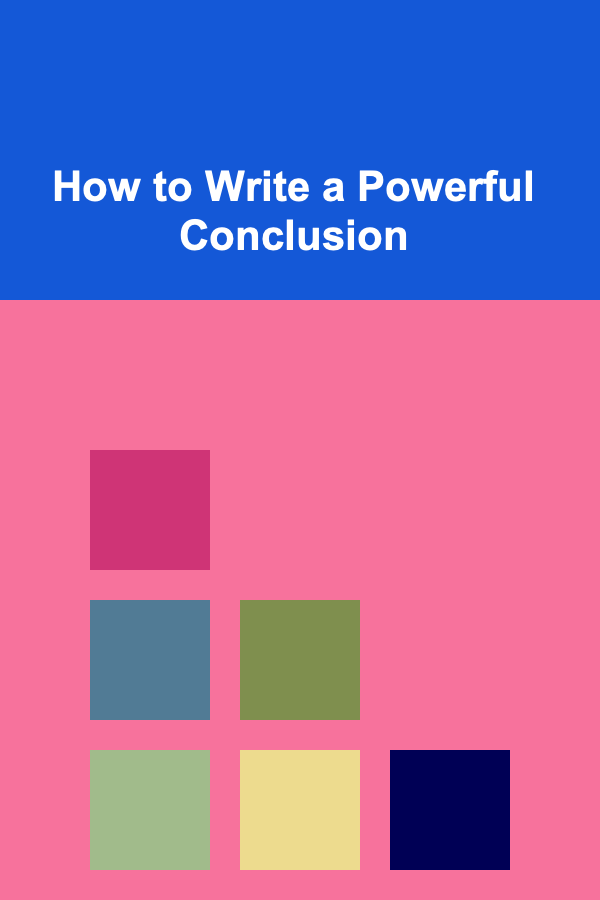
How to Write a Powerful Conclusion
ebook include PDF & Audio bundle (Micro Guide)
$12.99$7.99
Limited Time Offer! Order within the next:

A conclusion is more than just the final paragraph of a piece of writing. It's the culmination of your arguments, the echo of your thesis, and the lasting impression you leave on your reader. A weak conclusion can undermine even the most compelling arguments presented earlier, leaving the reader feeling unsatisfied and questioning the value of their time spent reading. Therefore, mastering the art of crafting a powerful conclusion is crucial for any writer aiming to inform, persuade, or entertain effectively.
This article will delve deep into the various strategies and techniques required to write conclusions that resonate, reinforce your message, and leave a lasting impact. We will explore the purpose of a conclusion, common pitfalls to avoid, different approaches to crafting a strong ending, and practical examples to illustrate these principles.
The Purpose of a Conclusion: Beyond Summarization
While a brief recap is often part of a good conclusion, simply summarizing your main points is insufficient. A conclusion should serve a much more significant purpose. Here's a breakdown of its key functions:
- Reinforce Your Thesis: The conclusion is your last opportunity to remind the reader of your central argument. It should not merely restate the thesis verbatim but rather reframe it in light of the evidence and analysis presented in the body of your writing.
- Synthesize and Connect Ideas: A strong conclusion draws together the various strands of your argument, highlighting the connections between them and demonstrating how they contribute to the overall thesis.
- Provide Closure: The conclusion should give the reader a sense of completeness and resolution. It should tie up loose ends and address any lingering questions or concerns.
- Leave a Lasting Impression: The conclusion is your final chance to influence the reader's perspective. It should be memorable and thought-provoking, encouraging the reader to reflect on the implications of your argument.
- Expand the Scope (Sometimes): In some cases, a conclusion can briefly suggest areas for further research or exploration, hinting at the broader implications of your findings. However, avoid introducing entirely new arguments or topics in the conclusion.
Common Pitfalls to Avoid in Conclusions
Many writers stumble when it comes to writing effective conclusions. Here are some common mistakes to avoid:
- Simply Restating the Introduction: This is a lazy and uninspired approach. The conclusion should build upon the ideas presented in the introduction, not simply reiterate them.
- Introducing New Information or Arguments: The conclusion is not the place to introduce new evidence or arguments. This can confuse the reader and undermine the coherence of your writing.
- Apologizing or Undermining Your Argument: Avoid phrases like "In conclusion, I may not have fully proven my point" or "This is just my opinion." This weakens your credibility and suggests a lack of confidence in your own arguments.
- Drifting Off-Topic: Stay focused on your thesis and the main points you have already made. Avoid tangents or irrelevant digressions.
- Being Repetitive or Redundant: While a brief recap is acceptable, avoid simply repeating the same points over and over again. Focus on synthesizing and connecting ideas in a new and insightful way.
- Overstating Your Claims: Avoid making exaggerated or unsubstantiated claims in the conclusion. Base your conclusions on the evidence and analysis you have presented.
- Ending Abruptly: A sudden and abrupt ending can leave the reader feeling unsatisfied. Provide a sense of closure and resolution.
- Being Too Vague or General: Avoid vague or general statements that lack substance or meaning. Be specific and concrete in your conclusions.
Strategies for Crafting a Powerful Conclusion
Now that we've covered the purpose of a conclusion and common pitfalls to avoid, let's explore some effective strategies for crafting a powerful ending.
1. The "So What?" Approach: Emphasize Significance
One of the most effective ways to strengthen your conclusion is to address the "so what?" question. Why should the reader care about your argument? What are the implications of your findings? Explain the significance of your work and its relevance to the reader's life or the broader world.
Example:
Thesis: The increasing reliance on social media for news consumption is contributing to political polarization.
Weak Conclusion: In conclusion, social media plays a significant role in how people get their news.
Stronger Conclusion: In conclusion, the filter bubbles and echo chambers created by social media algorithms are exacerbating political divisions. This trend threatens the foundations of informed democratic discourse and necessitates critical media literacy education to empower individuals to navigate the digital landscape responsibly and engage in constructive dialogue across ideological lines. The future of our civic society may depend on it.
In this example, the stronger conclusion doesn't just reiterate the thesis; it explains why the thesis matters. It highlights the potentially damaging consequences of political polarization and suggests a concrete solution.
2. The Call to Action: Inspire Action or Further Inquiry
If your writing aims to persuade or advocate for a particular cause, consider ending with a call to action. Encourage the reader to take specific steps to address the issue you have discussed or to engage in further inquiry.
Example:
Thesis: Increased investment in renewable energy sources is essential to mitigate the effects of climate change.
Weak Conclusion: In conclusion, renewable energy is important for the environment.
Stronger Conclusion: In conclusion, the urgency of the climate crisis demands immediate and decisive action. We must transition away from fossil fuels and embrace renewable energy sources as rapidly as possible. Contact your elected officials, support organizations working to promote clean energy, and make conscious choices in your daily life to reduce your carbon footprint. The future of our planet depends on our collective commitment to sustainable energy solutions.
The stronger conclusion moves beyond a general statement about renewable energy and challenges the reader to take concrete action to address climate change.
3. The "Look to the Future": Project Forward
Another effective technique is to project forward and discuss the potential future implications of your argument. What might happen if your suggestions are adopted? What are the potential consequences if they are ignored?
Example:
Thesis: The increasing automation of manufacturing processes will lead to widespread job displacement.
Weak Conclusion: In conclusion, automation is changing the job market.
Stronger Conclusion: In conclusion, the rise of automation presents both opportunities and challenges. While automation has the potential to increase productivity and create new industries, it also threatens to displace millions of workers. Unless policymakers and businesses proactively address the potential for job displacement through retraining programs, social safety nets, and innovative economic models, we risk creating a society marked by increasing inequality and social unrest. Preparing for this future is not just an economic imperative, but a moral one.
This conclusion looks ahead to the potential social and economic consequences of automation, urging proactive measures to mitigate the negative impacts.
4. The Return to the Hook: Create a Sense of Circularity
Consider revisiting the hook or anecdote you used in your introduction. This can create a sense of circularity and provide a satisfying sense of closure. Refer back to the initial example or story, but now reframe it in light of the arguments you have presented.
Example:
Introduction (Hook): "Imagine a world where clean water is a luxury, not a right. For millions of people around the globe, this is already a reality."
Thesis: Addressing the global water crisis requires a multi-faceted approach that includes investment in infrastructure, sustainable water management practices, and international cooperation.
Strong Conclusion: Returning to the image of a world where clean water is scarce, it is clear that the challenges are immense. However, by implementing sustainable water management practices, investing in infrastructure, and fostering international cooperation, we can move closer to a future where clean water is a right for all, not just a privilege for a few. The time to act is now, before that imagined dystopia becomes our reality.
The conclusion revisits the initial hook, reinforcing the urgency of the issue and highlighting the potential for positive change.
5. The Questioning Conclusion: Spark Further Thought
Instead of providing definitive answers, you can end with a thought-provoking question that encourages the reader to continue thinking about the topic. This can be particularly effective for essays that explore complex or controversial issues.
Example:
Thesis: The use of artificial intelligence in healthcare raises ethical concerns about privacy, bias, and accountability.
Weak Conclusion: In conclusion, AI is changing healthcare.
Stronger Conclusion: In conclusion, while the potential benefits of AI in healthcare are undeniable, the ethical implications are equally significant. As we increasingly rely on AI algorithms to diagnose illnesses, personalize treatments, and manage patient care, we must ask ourselves: How do we ensure that these technologies are used responsibly, ethically, and equitably, and who will be held accountable when things go wrong? The answers to these questions will shape the future of healthcare and the well-being of countless individuals.
The stronger conclusion leaves the reader with a set of critical questions to consider, prompting further reflection on the ethical implications of AI in healthcare.
6. The Anecdotal Conclusion: End on a Personal Note
In some cases, ending with a brief anecdote or personal story can be a powerful way to connect with the reader on an emotional level and reinforce your message. This is particularly effective for personal essays or narratives.
Example:
Thesis: Overcoming adversity requires resilience, perseverance, and a strong support system.
Strong Conclusion: I remember the day I received my diagnosis -- it felt like my world was crumbling. But through the unwavering support of my family and friends, and with a determined spirit, I learned to navigate the challenges and embrace a new normal. My journey has taught me that adversity is not a barrier to success, but an opportunity for growth. It's a reminder that resilience, perseverance, and the love of others can help us overcome even the most daunting obstacles.
The personal anecdote adds a layer of authenticity and emotional resonance to the conclusion, reinforcing the central theme of resilience.
Crafting the Perfect Conclusion: A Step-by-Step Guide
Here's a step-by-step guide to help you write a powerful conclusion:
- Review Your Thesis and Main Points: Before you start writing your conclusion, take a moment to review your thesis statement and the main arguments you presented in the body of your writing.
- Summarize (Briefly): Provide a concise summary of your key points, but avoid simply repeating yourself verbatim.
- Reframe Your Thesis: Restate your thesis in a new and insightful way, taking into account the evidence and analysis you have presented.
- Choose a Concluding Strategy: Select one or more of the strategies discussed above (e.g., "So What?" approach, call to action, look to the future) to craft a compelling ending.
- Address the "So What?" Question: Explain the significance of your argument and its relevance to the reader.
- Provide Closure: Tie up loose ends and give the reader a sense of completeness.
- Leave a Lasting Impression: End with a memorable and thought-provoking statement.
- Avoid Common Pitfalls: Be mindful of the common mistakes discussed above and avoid them in your conclusion.
- Revise and Edit: Once you have written your conclusion, revise and edit it carefully to ensure clarity, coherence, and impact.
Examples of Strong Conclusions from Literature
Let's examine some examples of powerful conclusions from well-known literary works:
To Kill a Mockingbird by Harper Lee:
"He turned out the light and went into Jem's room. He would be there all night, and he would be there when Jem waked up in the morning."
This simple yet poignant ending emphasizes Atticus Finch's unwavering love and support for his children, solidifying his role as a moral compass and protector.
1984 by George Orwell:
"He loved Big Brother."
This chilling final sentence reveals the complete and utter subjugation of Winston Smith's mind, highlighting the devastating power of totalitarianism.
The Great Gatsby by F. Scott Fitzgerald:
"So we beat on, boats against the current, borne back ceaselessly into the past."
This metaphorical ending captures the futility of chasing unattainable dreams and the persistent allure of the past, themes that are central to the novel.
Conclusion: The Art of Leaving a Mark
A powerful conclusion is not an afterthought; it is an integral part of effective writing. By understanding the purpose of a conclusion, avoiding common pitfalls, and employing the strategies discussed in this article, you can craft endings that resonate, reinforce your message, and leave a lasting impression on your readers. Mastering the art of the conclusion is about more than just finishing a piece of writing; it's about leaving your mark.
Remember, the conclusion is your final opportunity to connect with your audience, to persuade them of your point of view, or to inspire them to take action. Don't waste it. Invest the time and effort required to craft a conclusion that is both memorable and meaningful. Your writing will be all the stronger for it.

How To Choose the Right Nozzle Size for Your Prints
Read More
How to Create a Checklist for Developing Fundraising Materials and Collateral
Read More
How to Create a Statement Lighting Fixture on a Budget
Read More
How to Keep Track of Your Sewing Projects and Goals
Read More
How to Reduce Noise in Your Apartment Without Breaking the Lease
Read More
How to Build a Raspberry Pi Powered Robot
Read MoreOther Products

How To Choose the Right Nozzle Size for Your Prints
Read More
How to Create a Checklist for Developing Fundraising Materials and Collateral
Read More
How to Create a Statement Lighting Fixture on a Budget
Read More
How to Keep Track of Your Sewing Projects and Goals
Read More
How to Reduce Noise in Your Apartment Without Breaking the Lease
Read More